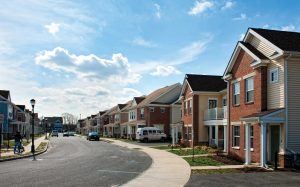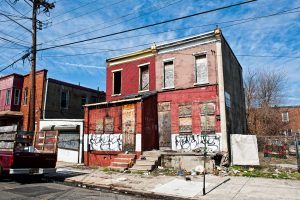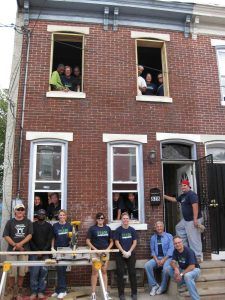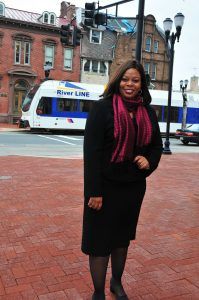Two people could tour Camden and end the day with very different points of view. One would describe a vibrant, developing town possibly poised to step out of its debilitating economic struggle. But the other would speak of a failing, poverty-stricken community that has been downtrodden for so long, little hope is left.
Both would be right.
Many sections of Camden are reaping huge benefits from major development projects, grass-roots programs and generous private donors. But some parts of the town remain desolate. Considering today’s economic and political climate, is there any way the many supporters working to change the river city can bring good fortune to all of the city’s neighborhoods? Camden is changing, no doubt, but how much will it change – and is there any chance the change can last?
Consider what a decade of public and private investment has created in Camden: the downtown is teeming with new higher-education and medical buildings set to bring an influx of students and workers into the city. The waterfront, a brick-and-steel wasteland of abandoned factories in the mid-1980s, is the setting of SJ’s greatest entertainment attractions, including the aquarium, the Riversharks and an amphitheater that draws major acts.
While the city remains overwhelmingly poor, a middle class is slowly gaining some ground. Beyond the 341 rental units at the luxurious Victor Lofts, historic Cooper Grant is a market-rate, close-knit enclave of professionals and young families. There are even pioneering Rutgers-Camden students migrating past the Ben Franklin Bridge – historically a dividing ground – into North Camden in search of cheaper rents and landlords who allow pets.

The Baldwin’s Run neighborhood in East Camden
New housing has replaced some of the city’s most notorious housing projects, from acclaimed Baldwin’s Run in East Camden, which rose on the site of Westfield Acres, to the townhouses and senior housing in Centerville. In Fairview, the last of Camden’s neighborhoods to lose its luster, the historic complexes that once housed shipbuilders are being refurbished. And in Cramer Hill, the Salvation Army’s $80 million Ray and Joan Kroc Corps Community Center will replace a massive landfill that stopped taking trash in 1969. The city also awaits the opening of the first grocery store in decades expected for Whitman Park and Parkside.
While slowed by the recession, progress is gaining as the city moves beyond its post-industrial ashes. However, the question for the times, says historian Howard Gillette, a Rutgers professor, is if – and when – the city of Camden can recover to the point of self-sufficiency. It’s a pressing matter, given how heavily the city has relied on state aid to supplement its depleted tax base, and the fact that Republican Governor Chris Christie has made reform his clarion call. While Christie’s cuts to municipalities have been across the board, they have most drastically impacted the poorest cities.
“I do think the downtown will flesh out,” says Gillette, author of “Camden After the Fall,” a history of the city’s post-industrial decline and revival efforts. “There will be more…commerce that will improve the tax base. But the obvious concern is that the gap between the needs and generated revenue is so big. For the governor to be pressing the whole idea that Camden can be self-sufficient within the next three to five years is absurd.”
Local taxes cover just $21 million of the city’s proposed $139 million budget. Gillette contends the tax base will recover, especially as the economy improves, but not enough to overcome the chasm that has resulted from decades of policy and politics. Years of misuse has cemented Camden’s position as the repository of the region’s low-income housing and so-called nuisance industries, including a sprawling sewage treatment plant on 40 acres of riverfront land, a huge trash-burning facility, a prison and a massive cement plant.
According to Gillette, Camden’s star fell as Cherry Hill’s rose in the 1950s. The attraction of larger, subsidized single-family homes following World War II, highway systems that opened sleepy farmland communities to development and better schools sent upwardly mobile ex-urbanites to the suburbs.
“The opening of the Cherry Hill Mall was a turning point,” says Gillette. “It represented a significant shift. Camden didn’t find the right bridge to urban redevelopment. But, in retrospect, it would have been pretty hard to stop it from happening.”
Cities like Camden seem to be unfairly blamed for having poor people and the problems related to poverty, says Wendell Pritchett, chancellor of Rutgers-Camden and an urban historian. In reality, cities have traditionally been the launching ground for immigrants and the poor. The Camden of today is similar to the Camden romanticized by Walt Whitman in his era.
“There isn’t anybody in the world who knows the solution to creating economically diverse cities,” says Pritchett. “It’s not like we can flick a switch and bring back thousands of jobs that disappeared.”
But attempts have been made, from Great Society programs of the 1960s to the 1992 construction of Adventure Aquarium. The latest state intervention, 2002’s landmark Municipal Rehabilitation and Economic Recovery Act, put Camden under state control and delivered $175 million. The goal was to spur private development and lift Camden out of poverty. Using those measures, the state takeover was a colossal failure. Camden is the second most dangerous city in America and the poorest medium-sized city, according to national rankings.
The state takeover was also a missed opportunity to create a more efficient workforce that would adjust to the city’s declining population, says Kelly Francis, the longtime president of the city’s NAACP.
“Instead, just the opposite happened,” Francis notes. “The workforce expanded at a time that it should have been downsizing. This is why we now have the layoffs.”
An Eds-and-Meds Answer?
But if you look at the Recovery Act another way, the money has set the stage for the city’s growth as a center of education and healthcare, or “eds and meds,” the economic machine that will take Camden into its future, contends Louis Bezich, chairman of the Camden Higher Education and Healthcare Task Force.

Scenes throughout Camden
The fact that 30 percent of all private sector jobs in the city are provided by the city’s eight healthcare and higher-education anchor institutions is indicative that Camden’s present and future is tied to a high-tech, knowledge-based economy. Camden is well positioned to become a regional high-tech center as the economy recovers, Bezich says.
“That’s where the world and the country wants to go, and it bodes well for Camden in the long term,” says Bezich, vice president for administrative services at Camden County College (CCC). “The definition of an anchor institution is one that can sustain itself through economic downswings. Yes, we’re impacted by short-term economic issues. But in terms of long-term sustainability, we’re good. This is the kind of core economic base a city wants to have and to build upon.”
For example, at CCC, which enrolls nearly 2,500 students at its Camden campus, the college’s $19.6 million, 278,000-square-foot Camden Technology Center was the first new construction project completed using Recovery Act money. The state’s $3.5 million helped create a training facility for technology-driven careers in health, business and computer fields.
At Rutgers, the recovery money contributed to construction of a new law school in 2008, which has resulted in a need for more on-campus housing, says Pritchett. With 6,391 students, the largest enrollment ever, the campus has been a driver of growth in the Cooper Grant neighborhood and beyond. The school is expected to break ground this month on its latest expansion project, a $55 million, 12-story dormitory to accommodate 350 graduate students.
Pritchett says he is applying lessons that helped the University of Pennsylvania’s successful effort to transform its surrounding, once-seedy West Philadelphia neighborhood to a vibrant community by building student housing around its campus.
Rutgers’ plan is to grow enrollment to 7,500 students within the next few years, with approximately 2,000 living on or near campus. The hope is the increase in student residents would make the school a magnet for retail investors, he says. Currently some 520 students live in campus housing.
“That’s why I’m so focused on this dormitory,” says Pritchett, who previously was an associate dean at the University of Pennsylvania Law School.
The opening of the Cooper Medical School of Rowan University is also expected to be a catalyst, both to improve medical care for city residents and bring more residents and businesses to the city. With plans to enroll the first class of 40 to 50 students in the fall, the program will support more than 200 students within four years, as well as 100 employees. The development comes on the heels of the completion of Cooper University Hospital’s 10-story patient pavilion, a $220 million improvement – the largest single construction project in the city in more than 30 years.
While little of the recovery act money made it into the hands of Camden residents, one bright spot was the creation of an innovative $20,000 grant program that went to Camden homeowners for improvements. As Monsignor Robert McDermott of Saint Joseph Pro Cathedral Church tells it, the Camden Churches Organized For People went to Trenton to lobby for the grants after they realized no money was actually reaching the people it was supposed to help. They successfully secured $5 million of state recovery funding, as well as an additional $2.85 million from other state and city funds.
“It helped the people who have lived here a long time and have seen the decay, been victimized by the crime and the drugs, but can’t go anywhere,” says McDermott, also board chairman of Saint Joseph’s Carpenter Society.
Building Luxury
Yet another major element is also in the works: developer Carl Dranoff’s creation of a “city on the waterfront” that is expected to bring thousands of new residents within 10 years. Dranoff’s Victor Lofts, which brought the first market-rate housing to Camden in decades, sailed through the recession with 90-percent occupancy in the landmark 1909 factory-turned-luxury-rental building. While plans were always to add on, Dranoff says the process of obtaining permits is the only thing holding him back from starting Radio Lofts, the renovation of yet another 10-story factory into 80 condos. From there, he will start building three- or four-story townhouses. Over 10 years, he expects to build a mix of townhouses and high-rise buildings totaling approximately 1,500 units.
Asked about Camden’s current woes, Dranoff notes that Camden is in far better shape than Philadelphia’s Northern Liberties neighborhood – north of historic Old City – was when he started renovating former factories into lofts. People today look back and think the neighborhood was always fabulous, but it was far from it in the mid-1980s, he says. It was a slow and deliberate process, just like Camden today.
“We didn’t have the advantage…of having a beautiful waterfront like Camden has, and we didn’t have the public transit that Camden has and is often overlooked,” he says. “You can really tell when the stars are aligned and things are ready to take off. Believe me, we’re putting our money on it.”
Conducting Business
In Camden’s heyday, the wafting scent of tomatoes was the smell of success, as symbolic as Nipper, the iconic dog on the RCA Victor Talking Machine Company building.
Although the 142-year-old Campbell Soup Company no longer cans soup on Camden’s waterfront, the food company earns notoriety as the only major business to have stuck with the city through its decline.

Susquehanna Bank employees volunteer in city-wide programs
Susquehanna Bank, meanwhile, is a newcomer whose name is also closely associated with its adopted city. While most widely known for the entertainment center that bears its name, the financial institution is also the first major company to move its headquarters here in modern times. In 2008, bankers moved into the $18 million Ferry Terminal Building, the first privately financed office constructed in the city in more than four decades.
While there are always complexities surrounding any business decision, both companies say their strong commitment to revitalizing the city is a top reason for making Camden its home. It’s more than just talk; both companies give generously to local causes.
“This is where our company was founded and this is where our history is,” says Anthony Sanzio, Campbell spokesman.
Back in the days when people lined the streets to work the tomato harvest, Campbell’s 5,600-worker base was second in size only to RCA Victor, which employed 13,030, according to 1937 data. Although its factory shut down in 1990, the food industry giant is committed to staying in Camden, having completed an 80,000 square-foot addition in June. Its 1,200 employees and 500 independent contractors make Campbell – the city and county’s only Fortune 500 company – the fourth largest employer and city’s biggest taxpayer. In 2010 it paid $1.7 million to city coffers, says Sanzio.
While Campbell’s foundation has traditionally focused on helping its hometown, giving in excess of $1 million annually, its new 10-year, $10 million nutrition campaign brings its involvement to a new level. Their goal is to cut obesity and hunger among Camden’s 23,000 children by half by 2020.
The plan is ambitious – given that nearly 40 percent of the city’s children between ages 3 and 19 are obese, compared to the national rate of 17 percent, according to the Journal of the American Medical Association. Campbell’s initiative will make fresh fruits and vegetables more accessible, teach good nutrition, and get kids to exercise more, a particularly challenging goal due to the lack of access to safe outdoor play, says Kim Fremont Fortunato, hired last year to head the campaign.
The plan targets Parkside and North Camden, where Campbell chefs and dieticians have already been out to elementary schools and neighborhoods to give demonstrations and disseminate healthy foods and recipes.
“We are laser-focused on children, but we know it will have a ripple effect that will go beyond the kids to families,” says Fortunato. “We’re looking at behavior changes on a lot of different levels.”
Susquehanna
Following its corporate headquarters’ move to the waterfront in 2007, Susquehanna Bank took over naming rights for Camden’s prominent music and arts venue – now called Susquehanna Bank Center – which attracts an estimated 450,000 visitors for concerts annually and last year brought in $668,000 in revenue for the city.
The move worked on several levels, says Joe Lizza, president of Susquehanna’s Delaware Valley Division. It brings Susquehanna, with $13 billion in assets, to a central location for its branches and business interests. Beyond that, the move better positions the bank to help Camden.
“In terms of financial incentives, they were modest,” says Lizza. “[The move] was driven predominantly by a desire to put our money and presence where our mouth is: the desire to aid in the recovery of Camden. This was a way of taking that up to the next level.”
Beyond $500,000 worth of grants to city agencies and institutions in the past two years, bank representatives serve on more than ten non-profit boards within the city.
It is also the largest supporter of a major initiative with Rutgers-Camden to groom academically talented, low-income city students for college. Called the Rutgers Future Scholars program, the program includes residential summer programs at Rutgers as well as regular meetings with current Rutgers students who graduated from Camden schools. Susquehanna’s financial contribution to the program – more than $60,000 so far – covers the cost of staffing a program coordinator who facilitates the pre-college curriculum with the kids year-round.
Ruling the City: The First Year
If hard work and sheer willpower could turn around a troubled city, Mayor Dana Redd’s Camden would become SJ’s hub for a strong economy and high-paying jobs. The waterfront, which played such a central role in the city’s storied past, would be energized anew with residents, tourists and suburbanites.
“I still see Camden for what she can become,” says Redd, a Democrat whose tenure as the first mayor to assume full powers following the state’s historic takeover coincides with Republican Gov. Chris Christie’s game-changing election as a reformer bent on balancing New Jersey’s untamed budget.

Mayor Dana Redd in 2010, at the start of her term
“I’m very excited to come in at this time,” says the poised, 43-year-old Camden native who has spent some two decades rising through local Democratic ranks and has just completed her first year in the mayor’s office.
“Although we have a lot of work to do, we have an identity that’s emerging around our anchor institutions: our hospitals, our universities and our Fortune 500 partner, Campbell Soup, which has remained here in our city. Now we’re leveraging their developments and their investments with our neighborhoods.”
Yet Redd’s successes in “opening Camden for business” as she likes to say, and the restructuring of what was regarded as a bloated municipal workforce are not what Camden is known for these days. What has put the troubled city of 79,000 in both the national and international spotlight has been its massive layoffs of public safety officers – the result of a $26.5 million budget deficit caused by drastic cuts in state aid.
With all eyes watching the drama unfold every day, the city’s latest troubles could jeopardize any achievement the city can claim.
Since 160 police officers were cut in January, violent crime has spiked. The fire department, reduced by one-third of its manpower, has been strained. Meanwhile, government leaders in both Camden and Trenton put pressure on unions to give back benefits. Redd’s proposal to raise the tax levy by 23 percent – she says it would have put 47 police officers and 13 firefighters back on the streets – was rejected unanimously by the city council as too burdensome on city residents.
It would have meant the owner of a home valued at $26,000, the city average, would have paid about $13 more per month. Last month, after a $2.5 million payment in lieu of taxes from South Jersey Port Corp., Redd was able to re-hire 50 police officers and 15 firefighters – but only until June 30. Redd says she’ll work day and night to find a permanent solution.
So the drama plays out in both the media and on the streets of Camden, which even before the layoffs was ranked as the nation’s second most dangerous city. For these troubled times, many say, Redd is exactly the person you want working behind the scenes.
She is recognized by many as a tireless worker for her city, unafraid to tell a room full of laid off safety officers that the city – which has been dependent on state aid to supplement its limited tax base, high poverty and unemployment – must run more like a business. She is ever-present at city schools, church and community events, and on the streets, reading to children or addressing the concerns about the city’s future.
“If anybody should be in the office for mayor with what’s going on now, its Dana Redd,” says Clarence Bagwell, 66, a longtime community organizer associated with the Antioch Baptist Church, where Redd also attends. He is also director of housing for Respond, a North Camden non-profit group.
“She has a connection with the community and is well respected. She knows she’s dealing with people’s lives. She’ll go into a meeting of 75 to 100 people by herself, and she’ll get the respect,” Bagwell says.
Rep. Rob Andrews (D-N.J.), a longtime Redd supporter, says the mayor is doing the best job anybody could do under “virtually impossible circumstances.”
“It’s impossible to govern Camden if you can’t truly empathize with the people who live there,” says Andrews. “This is a young woman who has walked the walk of the people she’s representing.”
When she talks about public safety, it is through the lens of personal tragedy. At just 8-years-old, her parents were found dead in a Bordentown motel room in 1976. Although the crime scene was ruled a murder-suicide committed by her father, a Campbell labor leader, those close to her insist it was murder.
Raised by her grandparents in the Waterfront South neighborhood and surrounded by a supportive community, Redd graduated from Bishop Eustace Preparatory High School. She worked to support her younger brother while pursuing a business degree at Rutgers University-Camden.
Perhaps as a result of her horrific experience, the mayor is not one to grandstand about Camden’s plight or blame Camden’s past leaders or the governor for the situation. To her credit, says Andrews, she chooses not to politicize problems but instead devotes her time to solving them.
“A politician would be on CNN protesting these layoffs, saying it’s the Republican governor’s fault or it’s whoever’s fault,” he says. “It would be great press but it wouldn’t solve the problem. I think she’s chosen a wise course to try to be a problem-solver rather than the politically expedient course.”
As for Redd, she acknowledges that the job requires her tireless attention. She says she is heartened by the many people from all walks of life who offer her support along the way.
“Folks have elected me to take on the challenges and come up with solutions,” she says. “They congratulate me, but also say to me ‘you probably have the toughest job in America, tougher than the President of the United States.’ I have to agree.”
Teaching the Kids
In a poverty-stricken city where 37 percent of all residents are under 18 and only five percent of adults hold college degrees, one of Camden’s greatest needs is for transformative schools to lift both families and the city at large.
No school district in the nation can claim the blueprint for successfully educating urban youth – Camden is no exception. And it should be no surprise that the city’s top performers are the handful of up-and-coming charter schools and long established parochial ones. While the free charter schools have long waiting lists for coveted seats, the city’s tuition-charging Catholic schools have struggled over the years and recently started a capital campaign.
Both systems stand to benefit from reform efforts in Trenton, both proposed or underway, aimed at improving urban education and reigning in costs.
At the top of the game is LEAP Academy University Charter School, a pre-k through 12th grade school that – for the entirety of its existence – has sent every graduating senior off to college. That’s 60 kids every year for six years, a record that bests even SJ’s top suburban schools.
“Camden [public] schools, quite frankly, haven’t done a good job and it’s a very scary thing with so many kids dropping out,” says LEAP founder Gloria Bonilla Santiago, referring to the 20 percent drop-out rate last year at two of the district’s traditional high schools. “We have those same kids, but we provide a different environment for them.”LEAP’s waiting list for admission is 500-students long for elementary-age programs, 300-wide for high school.
Charter schools – public schools that operate independently of the school districts in which they’re located – have a small but growing presence in Camden. Currently, seven charter schools enroll approximately 3,000 students citywide, compared to almost 13,000 in the public schools. Funding per charter student is roughly 90 percent of the amount allocated per pupil for traditional schools.
Gov. Chris Christie has made growth of these schools a central tenet of his educational agenda while the state Department of Education approved applications in January for an unprecedented 23 new ones. Three are expected to open in Camden.
At LEAP, the recipe for success is a mix of small classroom sizes, increased classroom hours, access to education experts and high expectations of both educators and students. Beyond increased time on class work – eight hours a day, 200 days annually – students receive on-site medical care and social services, as well as regular college exposure through the academy’s connection to Rutgers-Camden.
Since starting in 1997, the 900-student school has amassed more than $75 million in operational support, nearly $20 million for special programs and $18 million in capital funding. It recently started a new science, technology, math and engineering program and purchased three properties in front of its high school.
The academy also employs rigorous – perhaps extraordinary – standards for teachers. Of ten educators evaluated during their third year at LEAP, all but one were let go for not making the grade. However, the teachers who remain and thrive are rewarded merit pay over their salary base, explains Bonilla Santiago, a Rutgers-Camden professor who helped write New Jersey’s charter school law.
“In a country like this one, we shouldn’t have to hold lotteries to get kids into good schools,” she says.
Leaders of the city’s Catholic schools are of similar mind, calling it an issue of equity and justice that these schools continue to thrive in a city where the median income is approximately $18,000. The Catholic school system, which has had a presence in the city for more than 100 years and included 11 schools three decades ago, is down to five kindergarten-through-eighth grade schools with a combined enrollment of 1,000. While officials of the Diocese of Camden have closed down and merged schools in recent years, they express a commitment to the Camden schools despite flagging enrollment.
“These schools have been anchors in these neighborhoods for decades,” says Sister Karen Dietrich, executive director of the newly formed Catholic Partnership Schools. “They served the immigrant population when it was a different immigrant population and have always been about being attentive to the needs of families and children, getting them to become fulfilled, successful adults.”
The numbers are compelling. While it costs just $6,000 to educate a child in these schools, compared to $16,850 in the public district, children in the five schools outperform students in the public schools on standardized tests. For example, 76 percent of Catholic school eighth graders were proficient or advanced in reading in 2010, compared to 17.5 percent of public school students, according to the partnership.
With 88 percent of its students qualifying for reduced or free lunch, the Catholic school population truly reflects that of the city at large. Parents are expected to pay $1,700 annually but receive additional tuition assistance.
The Catholic Partnership was formed to raise awareness of the schools and to seek out both corporate and individual donor investments, says Dietrich. A recent $1 million gift from a Voorhees couple was the first significant grant. The group hopes to raise enough funds to grow enrollment and to add more enrichment and afterschool activities.
“If you walk through the streets in Camden after school, the children aren’t playing. There aren’t organized sports. Those are things we’d like to bring,” says Dietrich.
The mission could get a huge boost if a state-sponsored voucher program becomes law. Legislation that would effectively create New Jersey’s first private school voucher program is making its way through both the House and Senate after years of heated debate. The vouchers, which are government-issued certificates or scholarships, would enable poor students in low-performing schools to attend private schools.
While Christie is a strong supporter, the plan has passionate critics, including the New Jersey Education Association (NJEA), representing the bulk of New Jersey’s teachers, who argue that giving money to private schools requires taking away from the public schools. In a mass mailing sent out recently, the NJEA warns that the plan would result in larger class sizes and elimination of programs.
Saving the Sick
For decades, three health institutions have shown long-lasting commitment to heal the sick in Camden. Our Lady of Lourdes Medical Center, Cooper University Hospital and Virtua all have maintained a presence in the city, pioneering outreach programs and spearheadingmulti-million-dollar building projects.
Last year, Our Lady of Lourdes Medical Center celebrated its 60th year providing healthcare in Camden. The hospital’s mission has always been to serve the needs of its surrounding community through programs like Osborn Family Health Center, which provides medical services to the uninsured and under-insured, and another community health clinic staffed by volunteer physicians. In 2005, the hospital invested $54 million to build a pavilion for its critical care units, emergency department and nursing school.
Virtua – who many thought left the city in 2000 when it transformed its in-patient hospital to an out-patient healthcare facility – provides an array of services, from a dental clinic to 24-hour emergency care to behavioral health
programs for kids with special emotional needs. Camden families can also take advantage of free health screenings at Virtua Camden.
And in addition to its planned medical school and a recently completed $220 million patient pavilion, Cooper University Hospital is now planning to invest in the city again, working on plans for a $105 million, five-story cancer center opposite the hospital’s emergency department. Construction is slated to begin this summer.
In a groundbreaking collaborative effort, all three institutions have formed a coalition to create an electronic database of the health records of Camden residents.
“The ultimate goal is that a provider will be able to log in and see previous information on a patient, from every source possible,” explains Jeffrey Brenner, MD, executive director for the Camden Coalition of Healthcare Providers. “It will improve the quality of care, and also our ability to coordinate care.”














